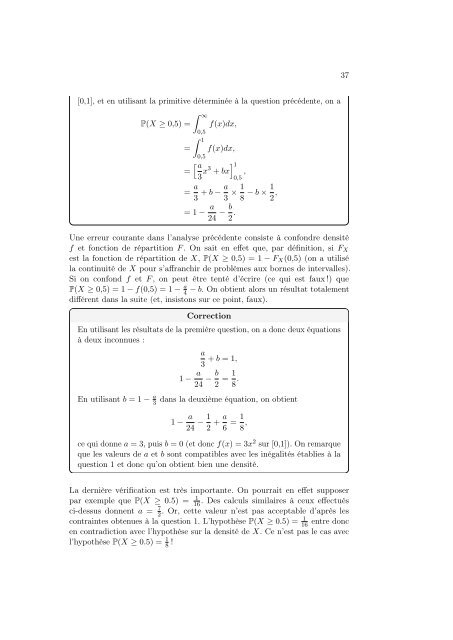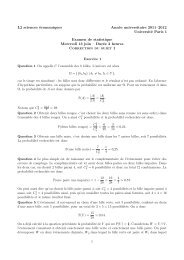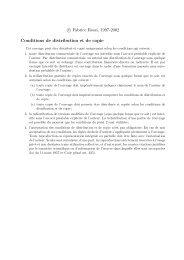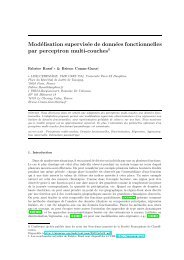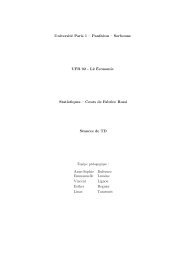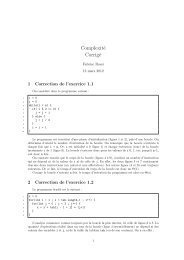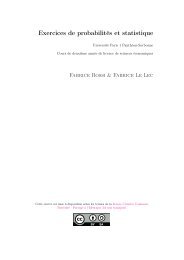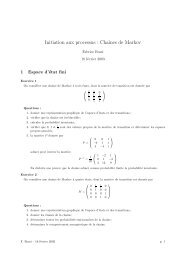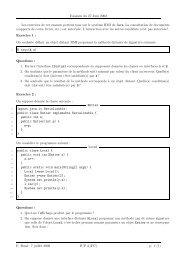Exercices corrigés de probabilités et statistique - Fabrice Rossi
Exercices corrigés de probabilités et statistique - Fabrice Rossi
Exercices corrigés de probabilités et statistique - Fabrice Rossi
You also want an ePaper? Increase the reach of your titles
YUMPU automatically turns print PDFs into web optimized ePapers that Google loves.
37<br />
[0,1], <strong>et</strong> en utilisant la primitive déterminée à la question précé<strong>de</strong>nte, on a<br />
∫ ∞<br />
P(X ≥ 0,5) = f(x)dx,<br />
0,5<br />
∫ 1<br />
= f(x)dx,<br />
0,5<br />
[ a<br />
=<br />
3 x3 + bx<br />
] 1<br />
0,5<br />
= a 3 + b − a 3 × 1 8 − b × 1 2 ,<br />
= 1 − a 24 − b 2 .<br />
,<br />
Une erreur courante dans l’analyse précé<strong>de</strong>nte consiste à confondre <strong>de</strong>nsité<br />
f <strong>et</strong> fonction <strong>de</strong> répartition F . On sait en eff<strong>et</strong> que, par définition, si F X<br />
est la fonction <strong>de</strong> répartition <strong>de</strong> X, P(X ≥ 0,5) = 1 − F X (0,5) (on a utilisé<br />
la continuité <strong>de</strong> X pour s’affranchir <strong>de</strong> problèmes aux bornes <strong>de</strong> intervalles).<br />
Si on confond f <strong>et</strong> F , on peut être tenté d’écrire (ce qui est faux !) que<br />
P(X ≥ 0,5) = 1 − f(0,5) = 1 − a 4<br />
− b. On obtient alors un résultat totalement<br />
différent dans la suite (<strong>et</strong>, insistons sur ce point, faux).<br />
Correction<br />
En utilisant les résultats <strong>de</strong> la première question, on a donc <strong>de</strong>ux équations<br />
à <strong>de</strong>ux inconnues :<br />
a<br />
3 + b = 1,<br />
1 − a 24 − b 2 = 1 8 .<br />
En utilisant b = 1 − a 3<br />
dans la <strong>de</strong>uxième équation, on obtient<br />
1 − a 24 − 1 2 + a 6 = 1 8 ,<br />
ce qui donne a = 3, puis b = 0 (<strong>et</strong> donc f(x) = 3x 2 sur [0,1]). On remarque<br />
que les valeurs <strong>de</strong> a <strong>et</strong> b sont compatibles avec les inégalités établies à la<br />
question 1 <strong>et</strong> donc qu’on obtient bien une <strong>de</strong>nsité.<br />
La <strong>de</strong>rnière vérification est très importante. On pourrait en eff<strong>et</strong> supposer<br />
par exemple que P(X ≥ 0.5) = 1<br />
16<br />
. Des calculs similaires à ceux effectués<br />
ci-<strong>de</strong>ssus donnent a = 7 2<br />
. Or, c<strong>et</strong>te valeur n’est pas acceptable d’après les<br />
contraintes obtenues à la question 1. L’hypothèse P(X ≥ 0.5) = 1<br />
16<br />
entre donc<br />
en contradiction avec l’hypothèse sur la <strong>de</strong>nsité <strong>de</strong> X. Ce n’est pas le cas avec<br />
l’hypothèse P(X ≥ 0.5) = 1 8 !


